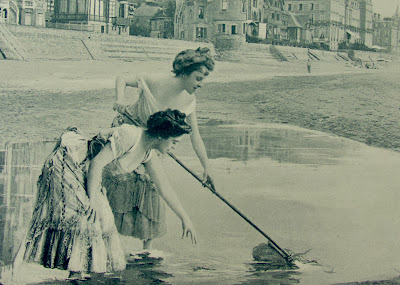Come lie with me and be my love
Love lie with me
Lie down with me
Under the cypress tree
In the sweet grasses
Where the wind lieth
Where the wind dieth
Lawrence Ferlinghetti (1919-2021), 1961
I have gotten a bit behind on my blog, but I think this charming bronze makes up for my neglect. It features two lovers at the seaside, the man, sprawling on the warm sand, gently urging his lovely lady to join him as he tugs at her skirt. She demurs, but her coy reluctance is certainly simply pro forma. How could she possibly resist such a magnificent mustache?!
Of golden bronze, this superbly detailed sculpture is 5 7/8 inches long and 4.25 inches high.
Underneath man is marked "M," "813" in an oval, and "S." This appears to be the mark of Moritz Spitz, one of the many foundries operating in Austria from the late 1800s through the early 1900s that created fine quality miniature bronze sculptures.
The slim yet muscular man wears the sort of casual outdoor gear that men of the late Victorian period through the early Edwardian period might don for a seaside stroll, a golf cap, short-sleeved knit striped shirt, knickers, ribbed socks, and walking shoes. His lady's outfit, with the low-cut sleeveless top and skirt raised to expose her lower legs clad in ribbed stockings and low-heeled shoes, is more of a mystery. It is not at all typical of the bathing suits of the era and certainly not something a proper woman would wear out on the street. However, the following photographs provide a clue. They are by French photographer Léopold-Émile Reutlinger, renown for his portraits of the most famous, and infamous, beauties of the Belle Epoque, from opera singers to performers from the Folies Bergères, as well as artistic erotic pictures, which were reproduced widely on postcards. The pictures are from "Le Panorama," a periodic art publication, and are entitled "Les Saisons, Etè" (The Seasons, Summer), No. 7. Issued in 1899, the "art" consists wholly of nubile ladies in scanty swimwear carefully posed and photographed by Reutlinger; it appears that many of the portraits were actually taken in a studio and then transposed over seaside scenes. Several of these pictures portray pulchritudinous Parisiennes fishing in the shallows with nets for shrimp and tiny fish. They appear to have removed their outer blouses or jackets and tucked up their skirts around their waists allow them to wade in the low waves. While I doubt many women in reality would dare such extreme public dishabille as pictured by Reutlinger, his imagery certainly is not wholly imaginary and a younger woman, especially on a lonelier stretch of beach, might shuck off a few heavy outer layers of clothing and tuck up her skirt in order to better enjoy the sun and sea. Perhaps that is what this little bronze beauty (undoubtedly with the encouragement of her beau) has done.







